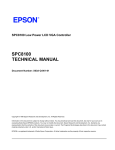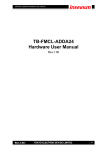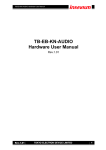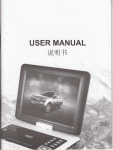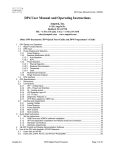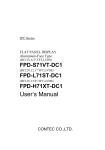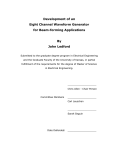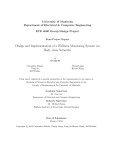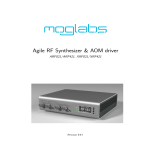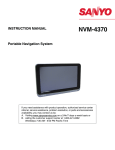Download Contents - Alexander T. Gill
Transcript
Multichannel DDS controller manual Alexander T. Gill August 25, 2011 Contents Contents i Overview Quick Specifications . . . . . . . . . . . . . . . . . . . . . . . . . . . . iii iv I User’s manual 1 1 External connections 2 2 Operating procedures 2.1 Turning on the box . . . . . . . . . . . . . . . . . . 2.2 Setting calibration values . . . . . . . . . . . . . . . 2.3 Generating a constant single-tone output . . . . . 2.4 Switching between multiple single-tone profiles . 2.5 Performing a frequency, amplitude or phase ramp 2.6 Powering down channels and restarting them . . 2.7 Turning off the box . . . . . . . . . . . . . . . . . . i . . . . . . . . . . . . . . . . . . . . . . . . . . . . . . . . . . . . . . . . . . . . . . . . . 4 4 4 5 5 5 7 8 CONTENTS ii 3 Troubleshooting 9 II Hardware manual 11 4 Circuit boards 12 5 Hardware 5.1 External hardware . . . . . . . . . . . . . . . . . . . . . . . . . 5.2 Electronics . . . . . . . . . . . . . . . . . . . . . . . . . . . . . . 19 19 19 6 Assembling the box 6.1 Preparing the boards . . . . . . . . . . . . . . . . . . . . . . . . 6.2 Making electrical connections . . . . . . . . . . . . . . . . . . . 6.3 Setting the evaluation board jumpers . . . . . . . . . . . . . . . 21 21 22 22 7 Future design considerations 27 III Programming manual 28 8 LabVIEW programming interface 8.1 Type definitions . . . . . . . . . . . . . . . . . . . . . . . . . . . 8.2 Top-level VIs . . . . . . . . . . . . . . . . . . . . . . . . . . . . . 8.3 Useful Sub-VIs . . . . . . . . . . . . . . . . . . . . . . . . . . . . 29 29 31 37 9 Extending the code 39 Overview The multichannel DDS controller (i.e. DDS box) is a circuit which provides direct access to four Analog Devices AD9910 evaluation boards for use in the laboratory. The AD9910 is a DDS (direct digital synthesizer) integrated circuit providing up to 400 MHz analog output. Each AD9910 chip is capable of storing up to eight preset single-tone settings called profiles which are accessible through fast switching of its profile pins. The chip has a digital ramping capability which enables controlled sweeping of the frequency, amplitude, or phase of the output. The four AD9910 evaluation boards constitute four independent and fully accessible channels of the DDS box. The box is controlled by a single USB interface and a set of external control pins which offer real-time access to the evaluation boards’ profile selection and ramping functions. A LabVIEW control program handles communication to the box from a PC. Unused channels may be externally powered down by front-panel switches or in software. Other features of the AD9910 which are not yet accessible in this implementation but which may be incorporated in future DDS box versions include: • RAM modulation mode, a function for generating arbitrary time dependent waveforms of amplitude, frequency, or phase using 1024 available words of 32-bit RAM, • output shift keying, a function enabling internal or external amplitude modulation of the chip’s output, • parallel data port modulation mode, a function for arbitrary fast control of the chip’s output using the 18-bit parallel data port, • and synchronization of multiple boards. iii OVERVIEW iv This document is divided into three parts: a user manual, a hardware manual, and a programming manual. The user manual provides instructions for the setup and basic use of the DDS box. The hardware manual explains how to construct a DDS box and provides information about its component parts. The programming manual describes the current LabVIEW programming interface for the DDS box. The programming interface consists of a set of low-level driver VIs which access the basic functions of the AD9910 chip. This programming interface can be incorporated into existing LabVIEW programs to add DDS functionality. Quick Specifications Output frequency 0 MHz to 400 MHz Output power 0 dBm to -70 dBm (approx) Power supply 5 V DC (max current draw 1.7 A, min current draw 0.5 A) Part I User’s manual 1 1 External connections Power connections The DDS box is powered by a single 5 V DC supply. The peak continuous current drawn will not exceed 2 A. Connect the 5 V and ground supplies via banana cables. RF outputs The RF output signals from each of the four channels are accessible via SMA connectors on the front panel. The output from any powered-down channel may be left unconnected. USB control The DDS box connects to its control computer through the USB type B socket on the front panel. I/O connections 20 additional input TTL control pins are accessible via the ribbon cable connector on the front panel. These pins safely accept both 5 V and 3.3 V logic. They are all passively pulled to ground, so when they are not in use, they may be left unconnected (this is the case when the only needed function for all channels is that of a constant singletone RF generator). These pins provide real-time access to the profile switching and the ramp control functions of each channel. See figure 1.1 for the pin-out diagram and chapter 2 for information on using these features. 2 nn Ch el 1 P0 an n Ch el 3 P0 an n Ch el 1 P an ne 1 l3 Ch P an 1 n Ch el 1 P a Ch n 2 an nel 3P n Ch el 1 2 Ch ann DRC an el 3 D TL n Ch el 1 RC IO an T ne UP L l3 DA IO TE UP DA TE Ch a nn Ch el 2 P0 an n Ch el 4 P0 an n Ch el 2 P1 an n Ch el 4 P1 an n Ch el 2 P2 an n Ch el 4 P2 an n Ch el 2 DR an n CT Ch el 4 L DR an ne CT l2 Ch L I an ne O UP l4 DA IO T UP E DA TE Ch a CHAPTER 1. EXTERNAL CONNECTIONS 10 1 3 20 11 Figure 1.1: Pin-out diagram of the ribbon connector socket for the front panel TTL inputs 2 Operating procedures 2.1 Turning on the box Apply 5 V power to the DDS box, and run a USB cable between the box and the control computer.1 The green LED on the USB interface should blink when it is ready to use. Ensure that all channels are switched to the on state before initializing the box using the LabVIEW interface. 2.2 Setting calibration values The accuracy of frequencies generated by the DDS channels depends on accurate knowledge of the reference clock frequencies. Slight deviations of the (nominally 1 GHz) reference frequencies can be calibrated out of each channel by supplying the known frequency values of the four oscillators. If the exact clock frequencies are not known, they may be determined in situ by using the following procedure on each channel: 1. Set the calibration reference clock frequency to 1000 MHz. 2. Set the channel to generate a 250 MHz single-tone frequency. 3. Measure the precise value of the output frequency. 4. Set the calibration reference clock frequency to 4 × the measured frequency. 1 When connecting the USB interface to a computer for the first time, allow the operating system to detect the new device, then follow the on-screen instructions to install the needed drivers (National Instruments Measurement & Automation Explorer must be installed for this to work properly). 4 CHAPTER 2. OPERATING PROCEDURES 5 The accuracy of the output RF power generated by the channels depends on prior knowledge of the full-scale output power. To set this calibration do the following for each channel: 1. Set the calibration full-scale output power to 0 dBm. 2. Set the channel to generate a single-tone RF output with power greater than or equal to 0 dBm. 3. Measure the precise value of the output power. 4. Set the calibration full-scale output power to the measured power. 2.3 Generating a constant single-tone output With the profile control pins of the desired channel disconnected or set to logic zero, load the RF generation parameters (frequency, amplitude, and phase offset) into the channel’s profile zero register using the LabVIEW interface. The channel’s RF output will immediately reflect the change in settings. 2.4 Switching between multiple single-tone profiles A single DDS channel may store up to eight single-tone profiles at one time. To enable fast switching between these profiles, load the RF generation parameters (frequency, amplitude, and phase offset) into the desired profiles. The channel’s RF output will immediately reflect the settings specified by the external logic supplied to profile control pins on the box’s front panel (see figure 1.1). The profile control pins for each channel labeled PO, P1, and P2 encode bits 0, 1, and 2, respectively, of the currently active profile number as table 2.1 shows explicitly. Use positive logic (either 3.3 V or 5 V) to set the profile pins. 2.5 Performing a frequency, amplitude or phase ramp Digital ramp generation is a mode of the AD9910 chip in which a single RF generation parameter (frequency, amplitude or phase offset) is linearly ramped (increased or decreased) as a function of time. The ramp may be continuous like a triangle ramp, or it may be set to wait for an external trigger. Both the rising and falling slopes of the ramp may be specified independently. Only the data for a single parameter ramp may be stored at one CHAPTER 2. OPERATING PROCEDURES 6 Table 2.1: Profile pin logic settings Profile 0 Profile 1 Profile 2 Profile 3 Profile 4 Profile 5 Profile 6 Profile 7 P2 0 0 0 0 1 1 1 1 P1 0 0 1 1 0 0 1 1 P0 0 1 0 1 0 1 0 1 time (i.e. there are not multiple “ramping profiles” that may be stored and accessed later the manner of single-tone profiles). Whenever one parameter is being ramped, the other two parameters are given by the currently active single-tone profile. To perform a digital ramp first ensure that the channel’s currently active single-tone profile has the desired static parameters. Then load into the channel the desired ramp generation parameters (the parameter to ramp, the limits and duration of the ramp, and the ramping pattern), and enable ramping using the LabVIEW software. Depending on the ramping pattern and the state of the DRCTL pin, the output parameter may begin ramping immediately from the low limit to the high limit, or else it will jump to the initial state and wait for a trigger to initiate the ramp. If a command to clear the digital ramp accumulator is sent from the software anytime during digital ramp generation mode, it effectively causes the ramping pattern to be reset to its initial state. The relevant front-panel control pins for ramping are the DRCTL pins (see figure 1.1). The following is a description of the four possible ramping patterns. Normal ramp Normal ramp is a manually triggered mode. The initial state of the ramp generator in this mode is always the lower ramp limit. If the DRCTL pin is initially active, the positive ramp will begin immediately. Otherwise, a low-tohigh transition on DRCTL initiates the positive ramp. When the ramp output reaches the upper limit, it will remain at that value until the next high-to-low transition on DRCTL, at which point it will begin the negative ramp. When the lower limit is reached, the positive ramp can be restarted with another CHAPTER 2. OPERATING PROCEDURES 7 low-to-high transition on DRCTL and so on. See figure 39 on the AD9910 data sheet for more information about normal ramp generation. No-dwell high No-dwell high is a manually triggered mode. The initial state of the ramp generator in this mode is the lower ramp limit. In this mode the ramp generator output is analogous to a sawtooth wave where the rising edge of the sawtooth is triggered by a low-to-high transition on DRCTL. When triggered, the output of the ramp generator will rise to the upper ramp limit, at which point it will immediately snap back to the lower ramp limit to await another trigger. See figure 40 on the AD9910 data sheet for more information about no-dwell ramp generation. No-dwell low No-dwell low mode is similar to no-dwell high mode except for the following differences. The output of the ramp generator is initially at the upper ramp limit. When triggered by a high-to-low transition on DRCTL, the output will ramp to the lower ramp limit, at which point it will immediately snap back to the upper ramp limit to await another trigger. Continuous ramp In continuous ramp mode the output of the ramp generator starts at the lower ramp limit and automatically oscillates between the two limits. In this mode the direction of the ramp can be changed midway through its progress, if desired, by toggling the DRCTL pin: a high-to-low transition on DRCTL will cause the output to “reverse” a positive ramp by beginning a negative ramp from the current output value. Likewise, a low-to-high transition on DRCTL will cause the output to begin a positive ramp from its current value. 2.6 Powering down channels and restarting them Channels can be externally powered down simply by flipping the front-panel switches to external power-down mode. This disables communication to the AD9910, however, so it should not be done during initialization of the channel. The channel will return to its previous state when the channel’s frontpanel switch is returned to the on position. CHAPTER 2. OPERATING PROCEDURES 8 A more complete power-down state can be achieved by issuing a powerdown command to the channel in software. This internal power-down state disables more subsystems of the AD9910 chip, allowing the channel to draw minimum current.2 Note that in an internal power-down state, serial communication is not disabled. The channel will return to its previous state when a wake-up command is issued in software. Note that in either power-down state no information uploaded to the chip since its last re-initialization will be lost. 2.7 Turning off the box Before turning off the DDS box, be sure to properly stop or close out the LabVIEW program that initialized it. This is to prevent memory leaks due to an open device reference. The box can be safely turned off by disconnecting its 5 V power supply. The USB interface may remain connected to the computer; it is powered by the USB line, so it will remain on as long at it is plugged in. 2 When all channels are set to their internal power-down states, the 0.5 A current draw of the box is dominated by the reference clocks which are not disabled. 3 Troubleshooting Here is a list of potential problems presented with possible solutions. Solutions are offered roughly in order of likelihood. Problem The DDS box does not respond to program commands. 1. Make sure that the channel being used is not switched to external power-down mode (front-panel switch). 2. Check the DDS board power supplies. 3. Check that the the channel’s data wires are securely connected to DDS board. 4. Check that power is being supplied to the IO board and that IO Update signals are getting through the OR gates to the DDS boards. 5. Make sure the jumpers on all of the DDS boards are set properly. 6. Reset the NI USB-8451 interface by first turning off the box, then unplugging the USB from the computer and plugging it back in. The green LED on the interface should blink when it is plugged in and ready to use. Problem No RF output. 1. Make sure that the channel being used is not switched to external power-down mode (front-panel switch). 2. Make sure that the channel is set to a profile for which the amplitude and frequency values specified in the LabVIEW control software are non-zero. 3. Check the DDS board power supplies. 9 CHAPTER 3. TROUBLESHOOTING 10 4. Check that the the channel’s data wires are securely connected to DDS board. 5. Check that power is being supplied to the IO board and that IO Update signals are getting through the OR gates to the DDS boards. 6. Check the power to the 1 GHz reference oscillators on the clock board. The board has one 3.3 V voltage regulator for power and another 1.65 V regulator providing a voltage reference. 7. Check the output of the reference clock by turning off the box, unplugging the SMA cable running from the clock board to the CLK INPUT port on the channel’s DDS board, and observing the signal with a frequency counter or spectrum analyzer. The clock signal should have a single 1 GHz frequency component with amplitude of about ?? dBm and no phase noise above ?? dB below the main peak. Problem The output has an unusual amount of amplitude or phase noise. 1. Check the DDS board power supplies. 2. Check the power to the 1 GHz reference oscillators on the clock board. The board has one 3.3 V voltage regulator for power and another 1.65 V regulator providing a voltage reference. 3. Check the output of the reference clock by turning off the box, unplugging the SMA cable running from the clock board to the CLK INPUT port on the channel’s DDS board, and observing the signal with a frequency counter or spectrum analyzer. The clock signal should have a single 1 GHz frequency component with amplitude of about ?? dBm and no phase noise above ?? dB below the main peak. Problem The box draws a lot of current (over 1 A) even when all of the channels are externally switched to power-down mode. Note that about 0.7 A is not unusual. 1. Make sure the jumpers on all of the DDS boards are set properly. 2. Look for short circuits. Part II Hardware manual 11 4 Circuit boards The DDS box contains three circuit boards in addition to the four AD9910 evaluation boards and the USB interface. These are the I/O interface board, the power supply board, and the clock board. These three boards take their 5 V and ground supplies directly from the case. See chapter 6 for details about the connections between boards. The I/O interface board takes input logic signals from the USB interface, the front panel switches, and the additional logic inputs. It buffers them where necessary and sends them to an output ribbon cable which splits off to various digital logic pins on the four evaluation boards. Note that for each channel IO update signals may come from either the USB interface or the front panel, so the IO update signal sent to the boards is the logical OR of these two input sources. The electrical schematic and board design are shown in figures 4.1 and 4.2 respectively. The power supply board provides power for the evaluation boards. For optimal performance each evaluation board requires two separately regulated 3.3 V and two separately regulated 1.8 V DC power sources. 16 low drop-out voltage regulators provide these sources which are supplied to the four evaluation boards through an output ribbon cable. The electrical schematic and board design are shown in figures 4.3 and 4.4 respectively. The clock board provides stable 1 GHz reference frequencies to each evaluation board. The AD9910 derives both its internal logic clock and its RF output from its reference clock input. Although each AD9910 evaluation board is capable of generating this 1 GHz reference via an on-board quartz oscillator and phase-locked-loop (PLL), experience has shown that phase noise and stability are greatly improved by using an external reference. The four 1 GHz output signals of the clock board are sent to the CLK INPUT ports of the evaluation boards via SMA cables. The electrical schematic and board design of the clock board are shown in figures 4.5 and 4.6 respectively. 12 CHAPTER 4. CIRCUIT BOARDS Figure 4.1: I/O board electrical schematic 13 CHAPTER 4. CIRCUIT BOARDS Figure 4.2: I/O board design 14 CHAPTER 4. CIRCUIT BOARDS Figure 4.3: Power supply board electrical schematic 15 CHAPTER 4. CIRCUIT BOARDS Figure 4.4: Power supply board design 16 CHAPTER 4. CIRCUIT BOARDS Figure 4.5: Clock board electrical schematic 17 CHAPTER 4. CIRCUIT BOARDS Figure 4.6: Clock board design 18 5 Hardware 5.1 External hardware Quantity 1 Item enclosure 4 switches 1 ribbon connector 2 1 banana sockets 5 V cooling fan 5.2 Description rack mount: 17.5 in. wide by 12 in. deep (or similar) SPST toggle (for external powerdown) 20 pin male panel mount (for external IO connections) for 5 V and ground power supplies Copal Electronics F251R-05LLC (or similar) Electronics Quantity 4 1 1 1 1 Item AD9910 evaluation boards NI USB-8451 I/O board Power supply board Clock board Description USB to serial communication interface 19 CHAPTER 5. HARDWARE 20 I/O board components Quantity 1 1 3 20 1 1 4 1 1 1 Type regulator IC IC resistor capacitor capacitor capacitor male header male header male header Value MC33269T-3.3 74LS32N SN74LVC245A 10 k 1 uF 10 uF 0.01 uF 2×17 pin 2×24 pin 2×30 pin Parts IC1 IC2 IC3–IC5 R1–R20 C1 C2 C3–C6 JP1 JP2 JP3 Power supply board components Quantity 8 8 32 1 1 Type regulator regulator capacitor male header male header Value MSP1825S-3.3 MSP1825S-1.8 1 uF 2×20 pin 1×3 pin Parts IC1–IC8 IC9–IC16 C1–C32 JP1 JP2 Value FVXO-LC73 MC33269T-3.3 LD1086V 100 ohm 237 ohm 76.8 ohm 0.01 uF 1 uF 10 uF 1×2 pin Parts IC1–IC4 IC5 IC6 R1–R4 R5 R6 C1–C4 C5 C6-C8 JP1 X1–X4 Clock board components Quantity 4 1 1 4 1 1 4 1 3 1 4 Type oscillator regulator regulator resistor resistor resistor capacitor capacitor capacitor male header female SMA jack 6 Assembling the box The following sections give detailed instructions on the assembly of a DDS box. See figure 6.1 for a suggested box layout. Attention should be paid to minimizing clutter by keeping wires short and bundling them where appropriate. While the DC regulators on the power supply board have not shown excessive heating, it is suggested to place the power supply board next to the cooling fan in an orientation that allows air to flow between the regulators before being exhausted from the box. Several holes in the side of the box opposite the fan will suffice for ventilation. Make appropriate labels for the front panel components. Each of the four channels has an SMA jack labeled RF OUT and a toggle switch with labels ON and PWR DN. Note that when the switch is in the on position (high) the center pin connects to ground, and when it is in the power-down position (low) the center pin connects to 3.3 V. Label the exposed USB socket of the NI USB-8451 USB. Label the male ribbon connector socket I/O connections. The user should refer to chapter 1 for the pin-out of this connector. Label the two banana cable connectors 5 V and GND. 6.1 Preparing the boards Refer to chapters 4 and 5 for diagrams and parts-lists for assembling the I/O, power supply, and clock boards. Note that all double-row header pins on the boards may be replaced with male ribbon connector sockets if available. This simplifies the process of connecting boards; just ensure that the orientation of the connector is correct before soldering. It may be practical to make the ribbon cables ahead of time to use as a reference (see section 6.2). 21 air vents Ch. 1 eval. board 22 Ch. 3 eval. board power to boards Ch. 2 eval. board Clock Power board supply board ref clock to boards cooling fan CHAPTER 6. ASSEMBLING THE BOX I/O board logic to boards USB Ch. 4 eval. board to front panel controls extra logic I/O pins power supply 5V and ground (banana connectors) Figure 6.1: Suggested DDS box internal layout (dimensions are approximate) 6.2 Making electrical connections The three home-made boards act as an electrical interface between the four evaluation boards and the outside world (the RF output is the only direct connection between the evaluation boards and the case). This serves both to compartmentalize the design and to protect the evaluation boards from accidental misuse (while the components of the home-make boards can be easily replaced, the evaluation boards can not). Table 6.1 gives the details of each electrical connection. Refer to figures 6.2 through 6.4 for the header pin assignments. 6.3 Setting the evaluation board jumpers Each AD9910 evaluation board has a set of jumpers which controls its mode of communication. The factory setting of these jumpers enables communi- Type 34 wire straight ribbon ≥48 wire straight ribbon 34 wire straight ribbon 40 wire twisted-pair ribbon wire wire SMA (rt-angle to rt-angle) SMA (rt-angle to bulkhead) jumper (or short wire) Qty 1 1 1 1 2 2 4 4 4 power supply board JP1 front panel power supplies front panel power supplies clock board outputs eval. board FILTERED IOUT (J4) port eval. board DRHOLD logic pin I/O board JP3 Termination 1 NI USB-8451 I/O board JP2 neighboring eval. board ground pin Termination 2 I/O board JP1 eval. board logic pins (via individual crimp connectors) front panel (switches, pwr supplies, I/O ribbon connector) eval. board power supply pins power supply board JP2 clock board JP1 eval. board CLK INPUT (J1) ports front panel Table 6.1: DDS box electrical connections CHAPTER 6. ASSEMBLING THE BOX 23 1 11 21 20 21 P0.7 CS4 P0.6 Ch an n Ch el 1 P0 an n Ch el 3 P0 an n Ch el 1 P an ne 1 l Ch an 3 P1 ne l1 Ch Ch ann P2 an el 3P n Ch el 1 2 Ch ann DRC an el 3 D TL n Ch el 1 RC I an ne O UP TL l3 DA IO T UP E DA TE 31 P0.7 CS4 P0.5 CS3 P0.4 20 P0.6 10 P0.5 CS3 11 P0.3 CS2 21 P0.4 1 P0.2 10 P0.3 CS2 11 P0.1 CS1 21 CS0 30 P0.2 P0.0 20 CS0 MOSI JP1 MOSI 1 MISO 11 MISO GND SCLK Gnd Gnd 10 P0.1 CS1 P0.0 GND 1P ard _0 B o 2 P_ ard 0 B o 3 P_ ard 0 4 Bo P ard _0 B o 1 P_ ard 1 B o 2 P_ ard 1 3 Bo P ard _1 4 Bo P ard _1 B o 1 P_ ard 2 B o 2 P_ ard 2 B o 3 P_ ard 2 4 Bo P ard _2 1 Bo D ard R_C T B o 2 DR L ard _C T Bo 3 DR L ard _C T B o 4 DR L ard _C TL Bo 1 IO _U ard P Bo 2 IO DAT _U E ard P Bo 3 IO DAT _U E ard P Bo 4 IO DAT _U E ard P Bo 1 CS DAT E ard B 2 Bo C ard SB Bo 3 CS ard B 4C SB ard 1 Bo Bo Gnd Gnd Gnd JP3 SCLK ard Bo 4 EX ard T_ P Bo 3 EX WR_ ard T_ DN P Bo 2 EX WR_ ard T_ D 1 E PWR N XT _D _P N Bo WR_ ard DN 1 Bo R ard ESE T B o 2 RE ard SE T Bo 3 RE ard SE 4R T Bo E ard SET B o 1 SC ard LK Bo 2 SC ard LK Bo 3 SC ard LK 4S Bo ard CLK 1 Bo S ard DO Bo 2 SD ard O Bo 3 SD ard O B o 4 SD ard O Bo 1 SD ard IO Bo 2 SD ard IO 3 Bo SD ar IO Bo ard d 4 S DI O Bo 1 IO _R ard E Bo 2 IO SET _R ard E Bo 3 IO SET _R ard 4 I ESET O_ RE SE T Bo gle To g V_ in sw f itc rom h c sw 1 lo ase To i gg tch w c (+5 le sw 2 lo onne V ) To w itc gg c ti c h o le sw 3 lo onne n w itc co ction h4 n low ne To c gg t le conn ion s To ec gg witc tio h le n sw 1 ce itc n h 3 ter Ch cen ter an n Ch el 1 P0 an n Ch el 3 P0 an n Ch el 1 P an ne 1 l Ch an 3 P1 ne l1 Ch Ch ann P2 el an 3P n Ch el 1 2 Ch ann DRC an el 3 D TL n Ch el 1 RC I an ne O UP TL l3 DA IO T UP E DA TE gle To g Ch an n Ch el 2 P0 an n Ch el 4 P an ne 0 l Ch an 2 P1 n Ch el 4 P1 an n Ch el 2 P an ne 2 l Ch an 4 P2 ne l Ch an 2 DR n CT Ch el 4 L DR an n CT Ch el 2 L IO an ne UP l4 DA IO T UP E DA TE Gn df r To om c gg le ase sw To itc gg h le sw 1 hi To gh itc gg h le c sw 2 hi onn To g itc e gg h 3 h co ctio le n sw nn h To i g itc e gg h 4 h co ctio le n sw n To itc high nec gg ti h le c sw 2 ce onn on Ch itc ec nt an er tio h n n Ch el 2 4 ce nt P0 an er n Ch el 4 P0 an n Ch el 2 P1 an n Ch el 4 P an ne 1 l Ch an 2 P2 n Ch el 4 P an ne 2 l Ch an 2 DR n CT L Ch el 4 DR an n CT L Ch el 2 IO an ne UP l4 DA IO T UP E DA TE CHAPTER 6. ASSEMBLING THE BOX 24 Front panel I/O connections 34 10 1 31 41 30 30 20 11 To male ribbon cable socket mounted on case: Connect the two ribbon connectors so that pins 1-20 on the front panel correspond to pins 15-34 on JP3. Wire pins from JP2 to the corresponding labelled pins on the four DDS evaluation boards. JP2 48 47 34 31 Wire corresponding pins 34 NI USB-8451 physical connections 31 Figure 6.2: I/O board header pin assignments Bo ard 1T 1T B1 -1 (V CC B1 _U -3 ard SB (D 3.3 2T VD V) B1 Bo D_ -1 ard IO ( VC 3.3 2T C B V) Bo _U 1-3 ard S B3 (D 3T VD .3 V) B1 Bo D _IO -1 ard (V 3.3 3T CC B1 V) Bo _U -3 ard SB (D 3.3 4T VD V) B1 Bo D _ -1 ard IO (V 3.3 4T CC Bo B1 V) _U ard -3 SB (D 1T 3.3 V DD B2 Bo V) -2 _IO ard (D 2T 3.3 AC B2 Bo _V V) -2 ard DD (D 3T 3.3 AC B2 Bo _V V) -2 ard D D (D 4T 3.3 AC B2 _V V) -2 DD Bo 3.3 ard (DAC _V V) 1T D B Bo D 1-4 3.3 ard (D V) 2T VD B1 Bo D -4 1.8 ard ( D V) 3T VD B1 Bo D -4 1.8 ard (D V) Bo 4T VD ard B1 D -4 1.8 1T (D B2 V) Bo VD -4 ard D (CL 1.8 2T K_ B2 V) Bo V D ard 4( D CL 1.8 3T K_ B2 V) Bo VD -4 ard D (CL 1.8 4T K _V B2 V) DD -4 (CL 1.8 K_ V) VD D 1.8 V) ard Bo Bo 1 11 Gnd 21 31 Gnd Gnd Gnd Gnd Gnd Gnd Gnd Gnd Gnd Gnd Gnd Gnd Gnd Gnd (G N 0V 0V 0V ) ) ) ard Bo ard 2T B2 -3 (G ND B2 0V -3 ) (G 3T ND B2 Bo 0V ard 3( ) GN 4T D B2 0V -3 ) (G ND 0V ) ard Bo Bo 1T D 0V ) 1T B2 -1 ard (G 2T ND B2 Bo 0V -1 ard ) (G 3T ND B2 Bo 0V -1 ard ) (G 4T ND B2 0V -1 ) (G ND 0V ) Bo Bo ard 1-2 TB GN D (G ND (G ND -2 ( B1 3T ard 4 Bo ard B1 -2 2T B1 -2 1T 5V Gnd Bo Bo ard ard Bo Gnd Gnd Gnd Gnd Gnd Gnd CHAPTER 6. ASSEMBLING THE BOX 25 JP2 Gnd Connect the center pin and one of the ground pins of JP2 on the power supply board to the case power supply. Connect the pins of JP1 on the power supply board to each of the labelled evaluation board power supplies by clamping the bare wire ends into the contacts. Ignore unused ground pins. JP1 40 39 Figure 6.3: Power supply board header pin assignments Connect the clock board power supply pins to the case power supply (5 V and GND). JP1 5V Connect the clock outputs to each of the DDS board reference clock input connectors via SMA. X1 Board 1 CLK_INPUT (J1) X2 Board 2 CLK_INPUT (J1) X3 Board 3 CLK_INPUT (J1) X4 Board 4 CLK_INPUT (J1) Figure 6.4: Clock board header pin and SMA jack assignments CHAPTER 6. ASSEMBLING THE BOX 26 cation via an on-board USB connection which interfaces with the AD9910 chip through an on-board field-programmable gate array (FPGA). Analog Devices ships a control program with graphical user interface (GUI) that uses this mode of communication. Since the DDS box has its own serial communication interface, this USB and FPGA circuitry must be bypassed on each evaluation board. To do this use the following jumper settings: W1: set to disable W2: set to disable W3: remove W4: set to disable W5: remove W6: remove Also ensure that the following factory standard jumper settings have not been changed: W7: set to REF CLK W11: no connection 7 Future design considerations There are currently three unused logic lines from the USB-8451 (they are the unused chip select pins). This is enough to provide a chip select, master reset, and IO update signal to an additional fifth channel if this is desired in the future. Doing so would require straightforward modifications to the other boards in the DDS box and would also require a larger enclosure. Increasing the number of channels per box beyond five would require a different solution for serial communication than is currently provided by the NI USB-8451. Modifying the DDS box to take advantage of the parallel data port modulation mode of the AD9910 will require the addition of 18 parallel data lines per channel. The I/O board may be modified to buffer these lines for the protection of the evaluation boards, or for convenience, they may be attached directly to the case. For timing purposes it will also be necessary to access each board’s TxENABLE input and/or PDCLK output. 27 Part III Programming manual 28 8 LabVIEW programming interface Note for programmers: as of August 2011 there is a bug in the National Instruments software which prevents VIs containing NI USB-8451 drivers from being launched directly from the LabVIEW project explorer window. There is a fix available in the National Instruments KnowledgeBase: see document ID 4IPG7TJL. 8.1 Type definitions AD9910 registers An enum containing the AD9910 register names. DDS box device reference A cluster containing data unique to a particular DDS box. It is used for identification and also contains calibration data. All of the top-level VIs take a DDS box device reference as input and return it as output. The cluster contains: NI USB-8451 device reference A unique handle for the USB-8451 (all available units will be listed as options when plugged in to the computer) DIO port Port number for the DIO lines (set to zero) Serial Clock Rate Sets the data transfer rate (in kHz) between the computer and USB-8451 (nominally 1000 kHz) Channels Settings An array containing calibration parameters for the four DDS channels. These consist of the reference clock rates (in MHz) and 29 CHAPTER 8. LABVIEW PROGRAMMING INTERFACE CS pin CS0 CS1 CS2 CS3 CS4 CS5 CS6 CS7 30 Assignment IO reset (all channels) Channel 4 chip select Channel 3 chip select Channel 2 chip select Channel 1 chip select (unassigned) (unassigned) (unassigned) Table 8.1: NI USB-8451 CS pin assignments the full-scale output power values (in dBm) of the channels. The reference clock rate is the measured frequency of a channel’s external oscillator on the clock board (nominally 1 GHz). The full-scale output power is the measured output RF power of the channel with its output amplitude set to maximum (nominally 0 dBm). DDS CS pins An enum containing the pin assignments of the USB-8451 chip select pins (see table 8.1). The values of the enums correspond to the USB-8451 CS pin number and the names of the enums indicate the associated channel number and AD9910 pin of the assignment. DDS DIO pins An enum containing the pin assignments of the USB-8451 digital I/O (DIO) pins (see table 8.2). The values of the enums correspond to the USB-8451 DIO pin number and the names of the enums indicate the associated channel number and AD9910 pin of the assignment. Digital ramping pattern An enum containing the possible ramping patterns for digital ramp generation mode. CHAPTER 8. LABVIEW PROGRAMMING INTERFACE DIO line P0.0 P0.1 P0.2 P0.3 P0.4 P0.5 P0.6 P0.7 31 Assignment Channel 4 master reset Channel 3 master reset Channel 2 master reset Channel 1 master reset Channel 1 IO update Channel 2 IO update Channel 3 IO update Channel 4 IO update Table 8.2: NI USB-8451 DIO line pin assignments 8.2 Top-level VIs DDS Close Type Inputs DDS ref in error in Outputs DDS ref out error out Notes DDS box device reference error cluster DDS box device reference error cluster Disables the SPI interface and sets the TTL lines to a high-impedance state then closes the USB-8451 device reference. To save computer resources this VI must be run to close out any open device before exiting the LabVIEW program. DDS Com Check Inputs DDS ref in channel number error in Outputs DDS ref out error out Type Notes DDS box device reference unsigned byte error cluster the channel (1–4) to check DDS box device reference error cluster Checks that serial communication with the specified channel is not interrupted. This assumes the channel is already initialized (an uninitialized channel will fail). CHAPTER 8. LABVIEW PROGRAMMING INTERFACE 32 DDS Disable Digital Ramp Inputs DDS ref in channel number error in Outputs DDS ref out error out Type Notes DDS box device reference unsigned byte error cluster the affected channel (1–4) DDS box device reference error cluster Disables digital ramping for the given channel, returning the channel to single-tone mode. DDS Initialize Type Inputs DDS ref in error in Outputs DDS ref out error out Notes DDS box device reference error cluster DDS box device reference error cluster Initializes the entire DDS box by enabling the SPI communication interface, initializing the states of the DIO lines, and initializing the channels by calling DDS Re-initialize One Channel on each. This requires that all channels be powered-on and that the external power down pins not be set. This is intended to be a one-time initialization since it causes a hard reset on all channels at once. Any channel that is disabled at the time of this VI call may be initialized later, if necessary, with an individual call to DDS Re-initialize One Channel. DDS Power Down Inputs DDS ref in channel number error in Outputs DDS ref out error out Type Notes DDS box device reference unsigned byte error cluster the channel (1–4) to power-down DDS box device reference error cluster Sets a single channel to an internal power-down state. This is a more effective power-saving state than can be achieved by simply turning off an CHAPTER 8. LABVIEW PROGRAMMING INTERFACE 33 active channel using its external power down pin. This VI does not affect any other data in the memory of the AD9910, so a subsequent call to DDS Wake Up will immediately return the channel to its previous state. A re-initialization of the channel or entire box will also clear the power-down state. DDS Re-initialize One Channel Inputs DDS ref in channel number error in Outputs DDS ref out error out Type Notes DDS box device reference unsigned byte error cluster the channel (1–4) to initialize DDS box device reference error cluster Resets and re-initializes the AD9910 registers for the specified channel. This clears all user data uploaded to the chip since the last initialization. The channel must not be in power-down mode at the time of this VI call. DDS Read Register Inputs DDS ref in channel number register error in Outputs DDS ref out read data error out Type Notes DDS box device reference unsigned byte AD9910 registers error cluster the channel (1–4) to read from the register to read DDS box device reference 1-D array of unsigned byte error cluster the register contents Reads the current value of the specified register in the specified channel. Note that when reading the contents of single-tone profile registers, only the profile register currently selected by the external profile pins can be read. CHAPTER 8. LABVIEW PROGRAMMING INTERFACE 34 DDS Set Amplitude Ramp Type Inputs DDS ref in channel number ramping pattern high amplitude low amplitude positive amplitude step DDS box device reference unsigned byte Digital ramping pattern double double double negative amplitude step double pos ramp step time neg ramp step time error in Outputs DDS ref out error out double double error cluster Notes the channel (1–4) to set ramp upper limit amplitude in dBm ramp lower limit amplitude in dBm increasing amplitude step (stated as a fraction of the total output amplitude) decreasing amplitude step (stated as a fraction of the total output amplitude) increasing step time in µs decreasing step time in µs DDS box device reference error cluster Prepares the specified DDS channel for a ramp of the amplitude of the RF output by loading the specified ramp generation parameters and enabling the ramp with amplitude set as the destination parameter. The frequency and phase offset parameters are determined by the currently active single-tone profile. It should be noted that while an effort has been made to keep all the RF amplitudes in units of dBm (decibels with respect to 1 mW output power) where possible, the amplitude ramp generated by the chip is intrinsically linear in the output current. Therefore the ramp is nonlinear in the output RF power given in either mW or in dBm. This aspect of the digital ramp generator cannot be changed, but arbitrary waveforms of amplitude could in principle be generated using the AD9910’s RAM modulation mode. CHAPTER 8. LABVIEW PROGRAMMING INTERFACE 35 DDS Set Frequency Ramp Type Inputs DDS ref in channel number ramping pattern high frequency low frequency positive frequency step negative frequency step pos ramp step time neg ramp step time error in Outputs DDS ref out error out Notes DDS box device reference unsigned byte Digital ramping pattern double double double double double double error cluster the channel (1–4) to set ramp upper limit frequency in MHz ramp lower limit frequency in MHz increasing step frequency in MHz decreasing step frequency in MHz increasing step time in µs decreasing step time in µs DDS box device reference error cluster Prepares the specified DDS channel for a frequency ramp by loading the specified ramp generation parameters and enabling the ramp with frequency set as the destination parameter. The amplitude and phase offset parameters are determined by the currently active single-tone profile. DDS Set Phase Ramp Type Inputs DDS ref in channel number ramping pattern high phase offset low phase offset positive phase step negative phase step pos ramp step time neg ramp step time error in Outputs DDS ref out error out DDS box device reference unsigned byte Digital ramping pattern double double double double double double error cluster Notes the channel (1–4) to set ramp upper limit phase offset in radians ramp lower limit phase offset in radians increasing phase step in radians decreasing phase step in radians increasing step time in µs decreasing step time in µs DDS box device reference error cluster Prepares the specified DDS channel for a ramp of the phase offset of the RF output by loading the specified ramp generation parameters and enabling the ramp with phase set as the destination parameter. The frequency and amplitude parameters are determined by the currently active single-tone profile. CHAPTER 8. LABVIEW PROGRAMMING INTERFACE 36 DDS Set Single-Tone Profile Inputs DDS ref in channel number profile frequency phase offset amplitude error in Outputs DDS ref out error out Type Notes DDS box device reference unsigned byte unsigned byte double double double error cluster the channel (1–4) to set the profile number (0–7) to set the frequency to load in MHz the phase offset to load in radians the amplitude to load in dBm DDS box device reference error cluster Loads the RF generation parameters of amplitude, phase offset, and frequency into the given single-tone profile of the given channel. DDS Wake Up Inputs DDS ref in channel number error in Outputs DDS ref out error out Type Notes DDS box device reference unsigned byte error cluster the channel (1–4) to wake DDS box device reference error cluster Wakes up the specified channel from a DDS Power Down command, restoring its previous state without erasing data. DDS Write Register Inputs DDS ref in channel number register write data error in Outputs DDS ref out error out Type Notes DDS box device reference unsigned byte AD9910 registers 1-D array of unsigned byte error cluster the channel (1–4) to load into the register to load into the data to upload DDS box device reference error cluster Writes data to the specified register in the specified channel. The number of bytes written must equal the register size in bytes (see the register map CHAPTER 8. LABVIEW PROGRAMMING INTERFACE 37 and bit descriptions section of the AD9910 data sheet for more information on registers). 8.3 Useful Sub-VIs DDS Pulse IO Reset Type Inputs spi script reference in error in Outputs spi script reference out error out Notes refnum error cluster refnum error cluster This VI must be used as part of an NI-845x SPI script. Issues a pulse to the IO Reset pin of all channels (currently one of the extra CS pins of the USB-8451). This clears the serial communication buffer of the AD9910 and readies it for a new data transmission. The IO Reset pins of all channels are physically connected via the IO board. It is not a problem that all channels share this signal since it does not directly affect the contents of chip memory, and only one channel communicates with the computer at a time. DDS Pulse IO Update Inputs spi script reference in port number channel number error in Outputs spi script reference out error out Type Notes refnum unsigned byte unsigned byte error cluster port number of the IO update pin the channel (1–4) to pulse refnum error cluster This VI must be used as part of an NI-845x SPI script. Issues a pulse to the IO Update pin of the specified channel (currently a DIO pin of the USB-8451). An IO Update pulse signals the AD9910 to transfer data from the serial buffer to memory. See the serial programming section of the AD9910 data sheet for more information. CHAPTER 8. LABVIEW PROGRAMMING INTERFACE 38 DDS Pulse Master Reset Inputs spi script reference in port number channel number error in Outputs spi script reference out error out Type Notes refnum unsigned byte unsigned byte error cluster port number of the master reset pin the channel (1–4) to pulse refnum error cluster This VI must be used as part of an NI-845x SPI script. Issues a pulse to the Master Reset pin of the specified channel (currently a DIO pin of the USB-8451). This returns the AD9910 to its default state, clearing all user data uploaded to the registers since the last reset pulse. Note that in the reset state the register settings of the AD9910 are not suitable for use in the DDS box; they must be reinitialized after a reset pulse. 9 Extending the code If a hardware change ever necessitates a re-shuffling of the CS and DIO pin assignments of the USB-8451, first make the necessary changes in the DDS CS pins and DDS DIO pins type definitions. If no assignments need to be switched from a CS pin to a DIO pin or vice versa, then nothing else needs to be done. Otherwise update the sub-VIs described in section 8.3 to reflect the changes. The current hardware setup should be sufficient to access the RAM modulation mode function of the AD9910. The only external pin needed to trigger RAM sweeps is IO update, which is already accessible from the DDS box front panel. The programming for RAM modulation mode should be similar to that for digital ramping: pre-load user data through the serial port, then enable the mode in the control registers. If the DDS box hardware is modified to enable parallel data port modulation, then the serial port will be needed first to initialize parallel data port modulation mode. Most of the work required to implement this mode, however, will involve the communication protocol between the chip and the fast electronics that will be used to control the parallel data lines. 39












































